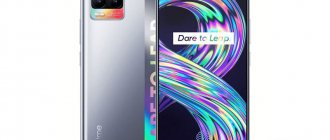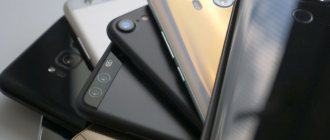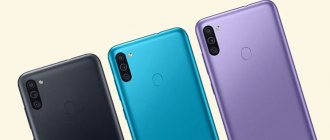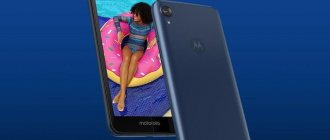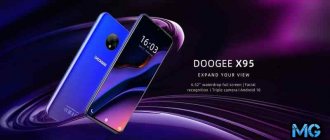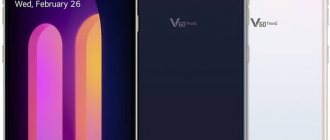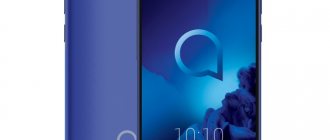A curious situation has developed in the smartphone market: in the price segment of 20-30 thousand, it’s not just crazy, but there is a noticeable shortage of interesting options (about which there will be another article in the future), up to 10 thousand rubles - there are options, but there has been some stagnation after continuous growth interesting offers in recent years. But in the segment from 10 to 20 thousand, everything is fine - every company counting on success in the relatively budget sector has released one, or even several interesting models. There are also curious “newcomers” from more expensive categories—last year’s representatives of the middle class who have fallen in price. In general, there is plenty to choose from.
⇡#Xiaomi POCO X3 NFC
- Operating system: Android 10 (proprietary MIUI shell with Poco Launcher).
- Display: 6.67 inches, IPS, 2400 × 1080.
- Platform: Qualcomm Snapdragon 732G (2 × Kryo 470 Gold, 2.3 GHz frequency and 6 × Kryo 470 Silver, 1.8 GHz frequency).
- RAM: 6 GB.
- Flash memory: 64/128 GB.
- Camera: 64+13+2+2 MP.
- Dual SIM cards, hybrid memory card slot.
- Battery capacity: 5160 mAh.
- Price: 18,939 rubles for the 6/64 GB version, about 20,000 rubles for the 6/128 GB version.
Why you should buy: the most powerful hardware platform in its class, excellent battery life, decent cameras.
What can stop it: large dimensions, combined memory card slot (critical for the 64 GB version).
At the start of sales, POCO X3 NFC looked like just a good smartphone that did not have a serious advantage over the same Redmi Note 9 Pro (as much better as it is more expensive) or realme 6 Pro. But just two months after the start of sales, its price dropped by 2-3 thousand - and now it looks much more attractive. And, for example, unlike the same realme 6 Pro, it was at least included in this list.
Actually, the main factor is the most powerful hardware platform among all competitors. Moreover, POCO X3 NFC outperforms even those that cost 10 thousand more, with a quite decent set of other characteristics. At the moment, in terms of price and quality, it surpasses the Redmi Note 9 Pro - and this puts it at the top of the list. The return of Pocophone was a success!
Alternative: Xiaomi Redmi Note 8 Pro. Last year's hero is still impressive - the Mediatek platform has not lost its face and remains relevant, the cameras have not become outdated, but the dimensions are more acceptable: after all, both Redmi Note 9 Pro and POCO X3 NFC are huge “shovels”, and this , well, a smaller spatula.
⇡#realme 7
- Operating system: Android 10 (branded ColorOS shell).
- Display: 6.5 inches, IPS, 2400 × 1080.
- Platform: MediaTek Dimensity 800U (two ARM Cortex-A76 cores at 2.4 GHz and six ARM Cortex-A55 cores at 2.0 GHz).
- RAM: 6/8 GB.
- Flash memory: 128 GB.
- Camera: 48+8+2+2 MP.
- Dual SIM cards, hybrid memory card slot.
- Battery capacity: 5000 mAh.
- Price: 19,125 rubles for the 8/128 GB version.
Why it’s worth buying: a fairly powerful hardware platform, moderate dimensions, a lot of memory (both permanent and RAM), good autonomy with very fast charging, a screen with 120 Hz mode.
What can stop it: it is less powerful than Redmi 9 Pro, and the camera is a little worse.
Xiaomi's new main budget competitors in the era of sanctions imposed on Huawei again performed very confidently, releasing two interesting smartphones in this price category this year - first realme 6, and then realme 7, which consolidated the success.
The latter is notable for its fresh Mediatek platform, which may be inferior to the Snapdragon 720G, but not by much, more balanced dimensions (the screen is still smaller - 6.5 inches) and a very generous offer in terms of built-in memory. On the Russian market there is only one, by the way, - 8/128 GB, although the 6/128 GB version also exists in nature. NFC is supported, there are no obvious contraindications. And yes, this is the only smartphone on the list that supports 120Hz screen refresh mode - and this is a pretty cool advantage. And one more thing, as Colombo used to say, this is the only 5G smartphone on the list. Even if it does not support the frequencies at which new generation networks will theoretically operate in Russia, the fact itself should be noted.
Alternative: realme 6 . The version from the first half of the year is just as generous in memory, but has a smaller battery and a simpler hardware platform. But it also costs a couple of thousand less - a trifle, but it can be significant.
Samsung Galaxy M01
Characteristics:
- Screen:5.7 “, 1520x720 (19:9), 294 ppi
- Memory:32 GB, RAM 3 GB
- Processor:8 core(s), 1.95 GHz
- Camera: 2 modules
- Battery capacity:4000mAh
- Weight:168 g
View on the official website
By purchasing this version of Samsung you get a compact smartphone, 3 gigabytes of RAM and 32 built-in, which is not bad for the money, since some manufacturers give 2.32 for 9000 rubles. Here the matrix is not amoled but a regular IPS. The processor is built-in from Snapdragon Qualcomm 439.
⇡#Xiaomi Redmi Note 9 Pro
- Operating system: Android 10 (MIUI proprietary shell).
- Display: 6.67 inches, IPS, 2400 × 1080.
- Platform: Qualcomm Snapdragon 720G (2 × Kryo 465 Gold, 2.3 GHz frequency and 6 × Kryo 465 Silver, 1.8 GHz frequency).
- RAM: 6 GB.
- Flash memory: 64/128 GB.
- Camera: 64+8+5+2 MP.
- Two SIM cards, separate slot for memory card.
- Battery capacity: 5020 mAh.
- Price: 17,390 rubles for the 6/64 GB version.
Why it’s worth buying: powerful hardware platform, good battery life, NFC, separate memory card slot, decent cameras.
What can stop it: advertising in the software shell, large dimensions, the front camera is not very good.
Xiaomi is second on the list - tough times call for tough decisions. And in fact, the choice of who exactly will take the top spot, POCO X3 NFC or Redmi Note 9 Pro, was very difficult. But putting the numbered Redmi Note there as the “default smartphone” would be too easy, especially since it is inferior to the POCO X3 NFC in terms of performance and wide-angle camera. But it benefits from a dedicated memory card slot.
But this is not enough for the title of reference smartphone in 2020 - it is being taken away by the revived Pocophone, which suddenly dropped in price a couple of months after its release and jumped into our price category. Moreover, we should not forget about the traditional features of Redmi in the form of advertising built right into the software shell.
Alternative: Xiaomi Redmi Note 9S. Almost a complete twin of the Redmi Note 9 Pro (exactly so absolute), but cheaper, without support for fast charging and without NFC. If paying with a smartphone at terminals is not critical for you, you can easily save a couple of thousand. It should also be noted, of course, that Redmi Note 9 is the 4/128 GB version you can get for 14 thousand rubles, but this is essentially a redesigned Note 8 Pro with a simpler camera. NFC is also available.
Honor 9X
- Operating system: Android 9 Pie with Magic UI shell.
- Display: 6.59 inches, IPS, 2340 × 1080.
- Platform: HiSilicon Kirin 710F (4 × ARM Cortex A73, 2.2 GHz frequency + 4 × ARM Cortex A53, 1.7 GHz frequency).
- RAM: 4/6 GB.
- Flash memory: 128 GB.
- Camera: 48+8+2 MP.
- Two SIM cards, the second slot is combined with a slot for a memory card.
- Battery capacity: 4000 mAh.
- Average price: 16,350 rubles for the Premium version with 6 GB of RAM.
Why it’s worth buying: retractable front camera, decent rear camera, decent performance.
What can stop it: retractable front camera, average battery life, no NFC.
In fact, the last pre-sanction Honor is with fully functioning Google services and at the same time has not had time to really become outdated. This year, a lot of interesting smartphones from Honor and Huawei were released, but, firstly, they all ran into the same dramatic limitation, and secondly, nothing came out in the middle segment that would really greatly surpass the same Honor in terms of characteristics 9X or its twin Huawei P Smart Z.
Moreover, Honor has updated its successful model from a year ago, releasing a Premium version with more RAM. The screen is without inclusions (the front is in a retractable module), large but not prohibitive (like the leaders of the list) dimensions, a well-placed fingerprint scanner - it is much more convenient to use on the rear panel than on the side. If it weren’t for the missing NFC and the slightly lagging camera, the result would be a smartphone with almost no weak points. But even so, it’s very worthy. Especially considering the price of 15-16 thousand rubles.
Alternative: Honor 30i. An ambiguous smartphone with bright advantages - an AMOLED display and a screen scanner, like the “big ones” - but without Google services. If they are not critical for you, then this smartphone definitely deserves attention.
Which smartphone under 20,000 rubles is better to buy?
Before purchasing a modern inexpensive mobile device, you need to pay attention to the characteristics. Initially, you should decide what to give your preference to - a high-quality and powerful camera or a capacious battery that can maintain autonomous operation of the device for a long time. In addition, when purchasing, you should take into account such technical characteristics of models as: display size, amount of RAM, screen resolution, weight, dimensions.
TOP smartphones under 20,000 rubles contains such notable models as:
- The most powerful smartphone – Xiaomi Mi 9T 6/64GB;
- Cheap smartphone with the necessary functionality – Huawei Y5 (2019) 32GB;
- Smartphone with the best camera – Honor 10i 128GB;
- If you need a smartphone with a powerful battery, then Tecno Camon 15 Pro is just right;
- Lightweight and convenient smartphone – Huawei Y5 (2019) 32GB;
- The smartphone with the best FaceID performance is Meizu Note 8 4/64GB.
Thus, good and inexpensive smartphones are currently available in abundance on the market in different versions. When choosing them, a large number of different factors should be taken into account. It is best to give preference to reliable and trusted manufacturers who can guarantee the reliability of their products; these are the smartphones that are included in the rating of smartphones under 20,000 rubles.
⇡#vivo V20 SE
- Operating system: Android 11 (proprietary FunTouch OS shell).
- Display: 6.44 inches, AMOLED, 2400 × 1080 pixels.
- Platform: Qualcomm Snapdragon 665 (4 × Kryo 260 Gold, 2.0 GHz and 4 × Kryo 260 Silver, 1.8 GHz).
- RAM: 8 GB.
- Flash memory: 128 GB.
- Camera: 48+2+2 MP.
- Two SIM cards, separate slot for memory card.
- Battery capacity: 4100 mAh.
- Price: 19,990 rubles.
Why it’s worth buying: AMOLED display, screen scanner, good ergonomics, plenty of memory (both flash and RAM), good battery life, stereo speakers.
What can stop it: there is no wide-angle camera, the performance is inferior to the leaders of the list (and noticeably throttles), the cutout.
The vivo company continues to produce quite successful, but not very noticeable smartphones for the mass public. The V20 SE is a perfect example. In terms of its totality of qualities, it is unique for its price range: okay, an AMOLED screen with an on-screen scanner (this is also on the Honor 30i), but such thin and light smartphones are practically rare in our age of shovels. And even with the opportunity to try Android 11 before anyone else.
But the vivo V20 SE is somewhat hampered by its price (it sticks closely to the top bar), not the best cooling system, which is why the smartphone has problems with throttling, as well as the lack of both an optical zoom and a wide-angle camera - an unprecedented “cheapness” even for state employees. not to mention the middle class. But overall, it’s an extremely nice device.
Alternative: vivo V17 . In fact, vivo V17 could well take the place of vivo V20 SE on the list and be even higher - it has a very good combination of characteristics (and there are no disadvantages in the form of a stripped-down camera and an unsuccessful cooling system), and even the price today starts at 17,000 rubles This is a purely emotional choice, dictated by Android 11 and the fact that the V20 SE has the most successful ergonomics among all in the selection.
⇡#Moto G9 Plus
- Operating system: Android 10.
- Display: 6.81 inches, IPS, 2400 × 1080 pixels.
- Platform: Qualcomm Snapdragon 730G (2 × Kryo 470 Gold, 2.2 GHz frequency and 6 × Kryo 470 Silver, 1.8 GHz frequency).
- RAM: 4 GB.
- Flash memory: 128 GB.
- Camera: 64+8+2+2 MP.
- Dual SIM cards, hybrid memory card slot.
- Battery capacity: 5000 mAh.
- Price: 16,990 rubles.
Why it’s worth buying: huge display, pure Android, powerful platform, good main camera, normal battery life + fast charging.
What can stop it: the smartphone is gigantic, there is not much RAM, the secondary cameras do not shine.
We talked about the most convenient smartphone in the selection - let's talk about the heftiest one. Giant screens, already close to the 7-inch mark, have reached the low-budget segment. The brand new Moto G9 Plus has a 6.81-inch LCD display.
And what’s most interesting (which is why I gave such an optimistic introduction), it’s good not only for this: at a price of 17 thousand rubles, it has a Snapdragon 730G (more powerful than the Redmi Note 9 Pro), a 64-megapixel main camera, and support 30 W charging with a 5000 milliamp-hour battery. Motorola is not only back, but it's going full force. If you need the largest possible screen, then there is no need to stop yourself.
Alternative: Oukitel K9 . There is, however, something larger on the market: Oukitel K9 does not shine with other characteristics (the camera is outdated, the platform is very so-so, and there is little memory), but it offers a 7.12-inch screen. I haven’t seen this smartphone in person, but it’s not hard to imagine: after all, 7-inch tablets and e-book readers are still in my memory.
Samsung Galaxy A21s
Characteristics:
- Screen:6.5 “, 1600x720 (20:9), 270 ppi
- Memory:32 GB, RAM 3 GB
- Processor:8 core(s), 2 GHz
- Camera: 4 modules
- Battery capacity:5000mAh
- Weight:192 g
The IPS matrix is quite bright at peak values even in the sun and naturally, to some eyes, IPS will seem nicer than Amoled, but we can say that due to this the battery is consumed less. HD+ resolution. A21s received a platform from Samsung exynos 850. It is relatively budget-friendly and consists of eight cortex a55 cores at a frequency of 2 GHz. A 5000 mAh battery that will last one and a half days of active use and three days of moderate use.
Top Samsungs up to 22000 in 2021
⇡#Samsung Galaxy M31
- Operating system: Android 10 (native shell).
- Display: 6.4 inches, Super AMOLED, 2340 × 1080.
- Platform: Samsung Exynos 9611 (four ARM Cortex-A73 cores at 2.3 GHz and four ARM Cortex-A53 cores at 1.7 GHz).
- RAM: 6 GB.
- Flash memory: 128 GB.
- Camera: 64+8+5+5 MP.
- Two SIM cards, separate slot for memory card.
- Battery capacity: 6000 mAh.
- Price: 19,980 rubles.
Why it’s worth buying: excellent battery life, AMOLED, good performance and camera, balanced dimensions.
What can stop it: the cutout, the plastic case is not the most pleasant to the touch, there is no fast charging.
Samsung is firmly committed to its budget line - the Galaxy M series looks really cool. Usually very stingy with the basic pleasures of the buyer (memory, powerful processor, capacious battery) - they say, they will buy it anyway because of the brand (and they did!) - the Korean company is now making very serious offers: here you have an AMOLED screen and 128 GB memory, and a battery of up to 6000 mAh.
The proprietary hardware platform may confuse you, but there is no need to be alarmed, it delivers decent performance, and the smartphone is perceived as very nimble. It doesn’t look too “noble” - Samsung saved a little on materials, and even on the style itself - but this is perhaps the main complaint that can be brought against this device (except perhaps for the lack of support for fast charging).
Alternative : Samsung Galaxy M21. The same advantages and disadvantages, but lowered half a level lower: the battery is just as healthy, but the hardware platform is simpler, and the memory is only 64 GB, but a dedicated memory card slot remains.
But it already costs 16 thousand rubles!
Samsung Galaxy A31
Characteristics:
- Screen:6.4 “, 2340×1080 (19.5:9), 411 ppi
- Memory:64GB, RAM 4GB
- Processor:8 core(s), 2 GHz
- Camera: 4 modules
- Battery capacity:5000mAh
- Weight:185 g
Samsung Galaxy A31 has a glossy plastic body, three color options: black, white and red. On the back cover in the upper corner there is a rectangular camera block. A fingerprint scanner is hidden under the screen, and it is optical, that is, it will have poor contact with wet hands, but it works in any plane. As for the screen itself, there is a juicy, bright Super Amoled display with a resolution of 1080 pixels by 2400.
⇡#OPPO A91
- Operating system: Android 9.0 (branded ColorOS shell).
- Display: 6.4 inches, AMOLED, 2400 × 1080.
- Platform: Mediatek Helio P70 (4 × ARM Cortex A73, 2.1 GHz frequency + 4 × ARM Cortex A53, 2.0 GHz frequency).
- RAM: 8 GB.
- Flash memory: 128 GB.
- Camera: 48+8+2+2 MP.
- Dual SIM cards, dedicated memory card slot.
- Battery capacity: 4025 mAh.
- Price: 17,990 rubles.
Why it’s worth buying: AMOLED display, a lot of memory (both permanent and RAM) + separate memory expansion slot, in-display fingerprint scanner.
What can stop it: Android 9.0, the fingerprint scanner works so-so, notch.
OPPO A91 was introduced in China back in December 2021, but only reached Russia in the long-suffering summer of 2020. This explains the fact that it runs on Android 9. Otherwise, it is a completely modern smartphone without particularly outstanding features, except, perhaps, an AMOLED display and a large amount of memory with a dedicated slot for MicroSD.
It has everything “normal”: moderate battery life with fast (but not the fastest among competitors) charging, an acceptable but not outstanding camera, a rather boring design, but full of bright color options, average performance. But the combination of all these qualities and, most importantly, the absence of noticeable shortcomings - it has NFC, despite the fact that there is practically no information about it - makes the OPPO A91 a very interesting and balanced option.
Alternative: OPPO A52 . A nice option from the “cheaper” category: for 13-15 thousand rubles you can get a smartphone with performance no lower than that of the OPPO A91, and a slightly larger screen, but no longer AMOLED; There is less memory here, the cameras are even simpler - nothing surprising. This is the same search for balance, but in a lower price category.
Smartphone up to 20,000 rubles, which company is better to choose?
If you need a reliable smartphone worth up to 20 thousand rubles, first of all you need to look at the following TOP manufacturers of the most popular models:
- Xiaomi. This famous Chinese brand appeared in 2010 and ranks 4th in smartphone sales in the country. The concern produces consumer and mobile electronics. Previously, the company was private, but in 2021 it changed its status, becoming public. Its operating income at this point exceeded US$24.5 billion.
- Tecno Mobile. Chinese mobile device manufacturer that started operating in 2006. The company was founded in Hong Kong and is part of the Transsion Holdings concern. When releasing gadgets, the emphasis is on a powerful battery, a high-quality camera, and a durable body.
- Samsung. The equipment manufacturer from South Korea began its activities in 1938. Currently the company is the largest concern in the country. Its net income as of 2021 exceeds $927 billion. In terms of total brand value in 2021, this brand was in 6th place in the world.
- Honor . The famous smartphone brand is owned by the equally famous Chinese electronics manufacturer Huawei Technologies. Since 2021, the company has been selling products mainly via the Internet. As a result, the company’s products have a fairly budget price, which distinguishes them from many other smartphone models.
- Meizu. The company began producing electronics in 2003. Initially, it specialized in the production of portable players. Then the products were somewhat expanded - since 2008, the company began actively producing modern high-tech smartphones. Unlike more well-known brands, their prices are more affordable for most buyers.
- Nokia . This Finnish company was founded in 1865. It gained its fame all over the world after the production of mobile phones began. For a whole decade, the company was a world leader in this industry. Recently, the company launched a line of smartphones, which it began to actively promote in the European market and in Russia.
- Sony. This Japanese corporation was founded in 1946. The company develops, produces and sells both professional and consumer electronics. Currently, Sony is one of the largest media conglomerates in the world.
- Motorola. This American company has become known throughout the world since the active spread of mobile phones. The company was founded in 1928. At one time, the corporation ranked 110th on the list of the 500 largest companies in the United States. The main activity of the organization is the production of integrated telecommunications and embedded electronic systems.
- Oppo. This Chinese consumer electronics company is not well known in Russia. It was registered in 2004. 4 years after this, the company entered the portable electronics segment. This prompted him to set up the production of mobile phones available to users; the company entered the Russian market only in 2013.
- Highscreen. This brand of smartphones is relatively new. Its active development and promotion began only in 2009. The development of mobile devices is carried out on the territory of the Russian Federation. Their production is established in China. The company targets mainly the markets of Ukraine, Russia, Kazakhstan and some nearby countries.
- Huawei. The company is considered one of the largest in the telecommunications segment. The corporation was founded in 1987. Its turnover as of 2021 was more than $75 billion. In 2015, the brand was among the top most successful smartphone manufacturers in the world. In subsequent years, the number of products only increased, despite increasing competition in the market.
- Realme. This Chinese smartphone manufacturer is a new company that was founded only in 2018. In addition to mobile devices, the company produces a variety of headphones, fitness bracelets, etc. Despite the fact that the brand is still unknown, it is currently being promoted and searching for markets for its products.
The best 4 inch smartphones
⇡#Nokia 5.3
- Operating system: Android 10.
- Display: 6.55 inches, IPS, 1600 × 720.
- Platform: Qualcomm Snapdragon 665 (four Kryo 260 Gold cores, 2.0 GHz + four Kryo 260 Silver cores, 1.8 GHz).
- RAM: 3/4/6 GB.
- Flash memory: 64 GB.
- Camera: 13+5+2+2 MP.
- Dual SIM cards and a dedicated memory card slot.
- Battery capacity: 4000 mAh.
- Price: 12,990 rubles for the 4/64 GB version.
Why you should buy: pure Android, price, fingerprint scanner on the rear panel, composite body.
What can stop you: low display resolution, average performance, slow charging, notch.
A good choice if you are looking for something cheaper: Nokia 5.3 does not particularly shine with its characteristics compared to all the other participants in the selection and it does not have outstanding qualities, but it is a fairly “smooth” device, without failures, and it costs 12 thousand rubles for version 4/64 GB, and not 16-20 thousand, like everyone else in the collection. The mediocre optimization can be somewhat confusing - despite a fairly good hardware platform, the device does not work quickly. But if you don’t have gaming ambitions, you love classic design, and even appreciate classic brands, this is a normal choice.
Alternative: Honor 10X Lite . This fresh smartphone is noticeably larger and more interesting in terms of characteristics, and is sold “by default” for 17 thousand rubles - but the offers are replete with discounts and gifts, so snatching it for 14 thousand, and even with a fitness bracelet to boot, is quite possible. If the availability of Google services is not critical for you and you are ready to overcome such an inconvenience, this option is quite good.
Samsung Galaxy M11
Characteristics:
- Screen: 6.4 “, 1560x720 (19.5:9), 268 ppi
- Memory:32 GB, RAM 3 GB
- Processor:8 core(s), 1.8 GHz
- Camera: 3 modules
- Battery capacity:5000mAh
- Weight:197 g
This Samsung smartphone model is almost similar to the A11. It differs in that there is 3 GB of RAM. The battery here is 5000 mAh. The body of the device is made of matte plastic and is quite practical, since it does not leave fingerprints. This version has three colors to choose from: black, turquoise and purple. There are also three built-in cameras. It is worth noting that there is a good reserve of brightness, which is quite enough for comfortable use in sunny weather outside, and the minimum value will be enough to use it somewhere in a dark room.
⇡#Palm PVG100
- Operating system: Android 8.1 Oreo.
- Display: 3.3 inches, IPS, 720 × 1280.
- Platform: Qualcomm Snapdragon 435 (4 × Cortex-A53, 1.4 GHz frequency and 4 × Cortex-A53, 1.1 GHz frequency).
- RAM: 3 GB.
- Flash memory: 32 GB.
- Camera: 12 MP.
- Two SIM cards, no memory card slot.
- Battery capacity: 800 mAh.
- Price: 17,990 rubles.
Why you should buy it: The smallest smartphone in the world.
What can stop it: little memory, no memory expansion slot, no NFC, weak processor, insignificant battery life, will soon go out of stock.
The strangest smartphone on the market. A miniature gadget that looks like a toy, but turns out to be a fully-fledged smartphone with an interface quite well adapted to work on a small screen.
A lot of shortcomings (from weak performance to no autonomy) at a very high price (at the start it cost 30 thousand rubles) killed the prospects of this “smartphone for digital detox”, but at the end of its cycle it may have some meaning - for 18 thousand, what it's worth today, it still looks like a wild buy, but not as wild as it once was. But no one will have this for sure.
Alternative: this kid has no alternatives.
Rating of smartphones up to 20,000 rubles
In order to select the best smartphones under 20,000 rubles, user reviews on various Internet resources were analyzed. Additionally, the opinion of experts who follow all the new developments in the world of IT technologies was also taken into account. The rating was also influenced by data obtained from testing various models. Main technical characteristics, functionality and parameters of smartphones that influenced their inclusion in the TOP:
- Operating system type;
- Supports multiple SIM cards;
- Screen diagonal;
- Display resolution;
- Memory and the presence of a slot for a memory card;
- Cameras and their matrix resolutions;
- Amount of RAM;
- Battery capacity;
- Weight;
- Dimensions.
The best 128 GB smartphones
